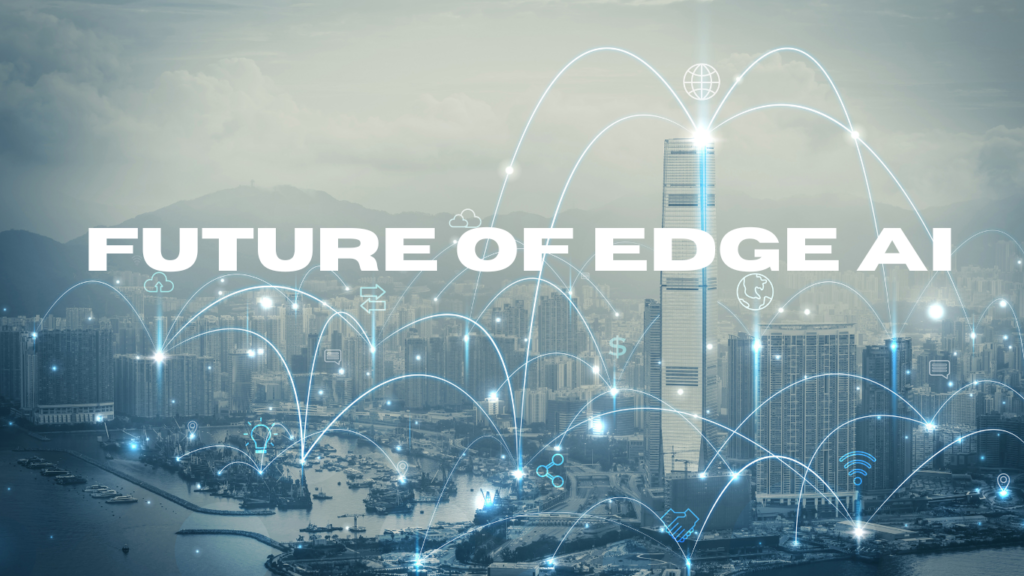Unlocking the Future with Edge AI: Explore Innovative Solutions for Real-time Intelligence at the Edge of Possibility.
Have you ever considered how technology might make intellect more accessible to those who live, work, and play in those places? The idea of Edge AI is emerging as a solution in a world where data is produced at an unprecedented rate, and it not only processes information locally but also changes how we interact with the digital world.
Today, we’ll explore the field of edge artificial intelligence, including its definition, guiding principles, advantages, practical applications, and complex interactions with cloud computing. So, let’s go out on a quest to explore the fascinating world of AI and all of its potential.
How Does Edge AI Function and What Is It?

This AI refers to installing AI programs on hardware all around the real world. In contrast to conventional AI systems, which rely on centralized cloud computing infrastructure, Edge AI analyses data at the network’s edge, close to the user. Retail establishments, manufacturing facilities, healthcare facilities, and Internet of Things (IoT) components like traffic lights and autonomous machines can all be called “edge” locations.
The effective deployment of AI models at the edge has been made possible by recent technological advancements. These consist of:
Maturation of Neural Networks
Organizations can now successfully train and deploy AI models at the edge because of advancements in neural networks and related AI infrastructure.
Advances in Compute Infrastructure
Creating highly parallel GPUs has given us the computing capacity required to effectively operate AI at the edge.
Adoption of IoT Devices
Large amounts of data have been produced by the widespread adoption of the Internet of Things (IoT)’s widespread adoption, enabling the deployment of AI models at the edge. The introduction of 5G technology has also improved IoT connectivity by allowing quicker, more reliable, and secure data transmission.
Why Deploy AI at the Edge? What Are the Benefits of Edge AI?
Edge AI has many advantages that make it a desirable choice for many applications:
Intelligence in Edge AI
Compared to traditional applications, AI apps are more adaptable since they can handle a variety of inputs, including text, speech, and video, without the need for set rules. They are quite adaptive and may change to various kinds of inquiries.
Real-time Insights
Edge AI does local data analysis, providing in-the-moment solutions and attending to users’ urgent needs, which is especially important for applications that require quick responses.
Reduced Cost of Edge AI
It eliminates the requirement for large amounts of internet traffic by processing data closer to the edge, which results in significant networking cost savings.
Increased Privacy
By processing data locally and uploading only anonymized analysis and insights to the cloud, Edge improves privacy while minimizing privacy concerns and challenges with regulatory compliance.
High Availability
Since the AI of Edge doesn’t require constant internet access, it is more durable and dependable. High availability for mission-critical applications is thereby guaranteed.
Persistent Improvement
The accuracy of edge models for AI increases over time as they encounter and learn from new data.
How Does Edge AI Technology Work?

Deep neural networks (DNNs) are used by Edge AI to simulate human cognition. These DNNs are trained on huge datasets to respond to particular inquiries. Deep learning training typically occurs in data centers or the cloud due to the computing demands and requirements for data scientist competence.
The trained model is transformed into an “inference engine” in edge deployments of AI, which can respond to questions from the actual world. It uses equipment in a variety of settings, including factories, hospitals, and automobiles. In order to improve the performance of the model, the system frequently uploads challenging data to the cloud for more model training. This feedback loop makes a substantial contribution to the ongoing development of edge models.
Examples of Edge AI Use Cases
It has applications in many different industries and has completely changed operations and results. Several prominent use cases include:
Intelligent Forecasting in Energy
In order to optimize energy generation, distribution, and management and guarantee a steady supply of energy, edge models aggregate historical data, weather information, and grid health information.
Predictive Maintenance in Manufacturing
Early anomaly detection and failure prediction are made possible by sensors on machinery, reducing downtime and enabling prompt repairs.
AI-powered Instruments in Healthcare
AI is used in modern medical equipment to facilitate less invasive surgeries and offer in-the-moment information during medical procedures.
Smart Virtual Assistants in Retail
To improve the customer experience, retailers use voice-activated ordering systems that let customers browse for products, get information, and place orders using voice commands.
The Role of Cloud Computing in Edge Computing

Edge AI can operate at the edge of the network as well as in centralized cloud data centers. While edge computing offers quicker reaction times, less bandwidth costs, and network resilience, cloud computing offers advantages relating to infrastructure cost, scalability, and collaboration.
Edge AI benefits greatly from cloud computing by:
Model Training by Edge AI
Before sending AI models to the edge, cloud infrastructure can train the models.
Model Updates
Models are continuously updated and retrained in the cloud using data produced at the edge, assuring model accuracy.
Complementing Edge Models
When high compute capacity is necessary, edge models can be supplemented by cloud-based AI inference engines, which send difficult jobs to the cloud for processing.
Serving the Latest Models by Edge AI
Edge devices always have access to the most recent AI models and apps thanks to cloud services.
The Future of Edge AI

Generalized machine learning at the edge now has a solid base thanks to the convergence of advanced parallel computing, widespread IoT use, mature neural networks, and 5G technology. Organizations from various industries are prepared to take advantage of AI’s enormous potential to improve operations, cut costs, and protect privacy.
The potential uses for Edge AI applications have yet to end as time goes on. Edge can potentially disrupt businesses and enhance our lives in ways we can’t yet completely fathom because of its capacity to deliver real-time insights, adapt to many settings, and constantly improve.
Organizations must stay current on the shifting trends in this game-changing technology to examine the possibilities and factors to consider while using this AI. As AI continues to transform the world of technology and innovation, the future presents promising opportunities.

